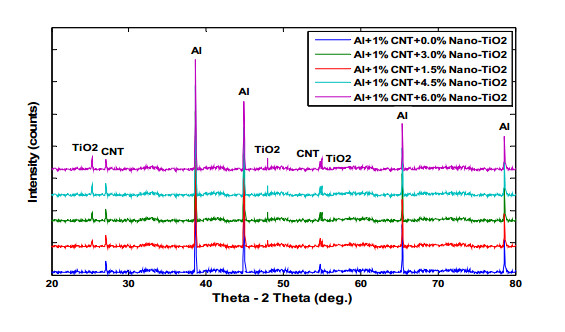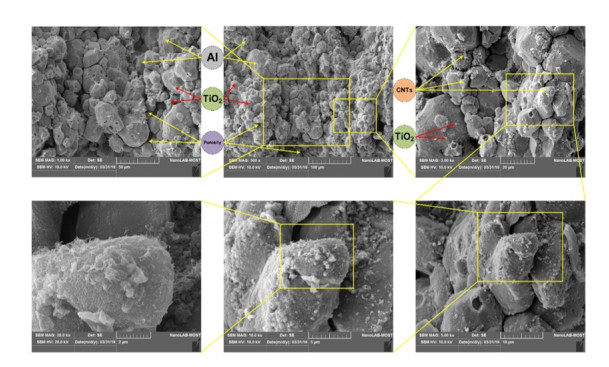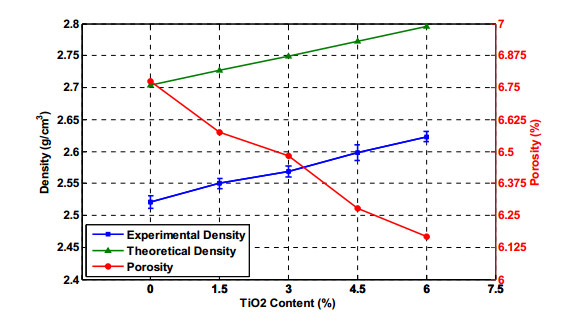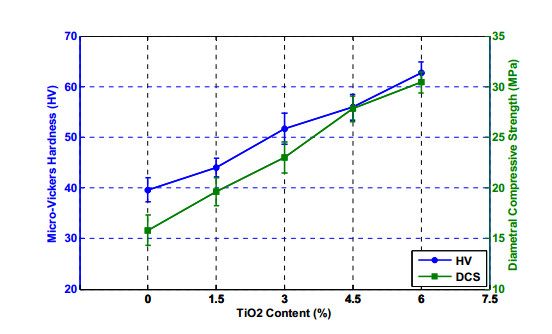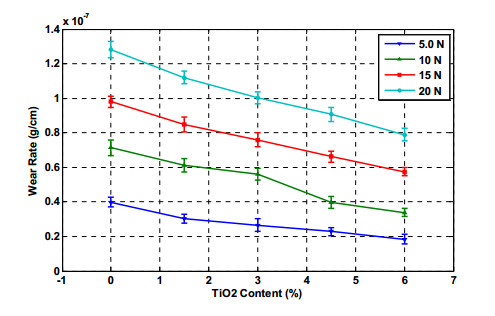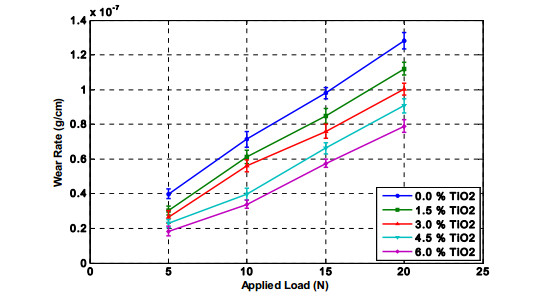In this study, a brief review of the effects of the various types of TiO2 nanoparticles and a fixed addition of CNTs to the aluminum matrix on the mechanical, microstructural, and wear characteristics of the resulting composites. Classical powder metallurgy technique was utilized to fabricate the hybrid nanocomposites in this study, while the hybrid nanocomposites were characterized using SEM and XRD. The mechanical properties of the hybrid nanocomposites were evaluated by testing their microhardness, wear tests, and diametral compressive strength. From the SEM and XRD analysis, there was a proper and homogenous distribution of the reinforced particles. Although there was some agglomeration, no intermetallic compounds were found. The study also revealed that the microhardness, diametral compressive strength, and wear resistance significantly improved when the TiO2 nanoparticle content was increased. Also, it was explained that the wear resistance negatively correlated with the applied loads.
1.
Introduction
Nowadays, the world is developing rapidly, especially in materials technology; engineers and scientists are looking forward to novel materials that are characterized by lightweight and strong performance. Aluminum and its alloys are utilized significantly in modern engineering applications because of their good strength and lightweight [1,2]. However, their utilization in several applications is hindered by their low hardness and low wear resistance. The extensive utilization of Aluminum Metal Matrix Composites (AMCs) in automotive and aerospace applications is attributed to the desirable characteristics, such as specific stiffness, thermal conductivity, high wear resistance, corrosion resistance, and low density. AMCs reinforced with ceramic particulate are considered the favorable solution for imparting high strength and consequently, suitable wear resistance to aluminum [2,3,4,5]. There are different ways of producing AMCs, such as stir casting, powder metallurgy, squeeze casting, etc. Among them, the Powder Metallurgy (PM) technique is known for its cost-effectiveness and simplicity. PM is used mainly in the fabrication of Aluminum matrix nano-composites (AMNCs) as it produces composites with uniform reinforcement distribution [6,7,8].
The process of Metal Matrix Composites (MMCs) preparation consists of the incorporation of either metallic or ceramic such as ZrO2, Al2O3, SiC, B4C, or TiO2 is considered essential to enhance mechanical properties and wear resistance [9,10,11,12] into the metal matrix. For MMCs, TiO2 is an excellent option due to its good hardness, low density, high melting point, high wear resistance, and good chemical stability. Wear resistance has been reported to improve by increasing the percentage of ceramic particles in Al. This is due to the hardness and high strength of the reinforcement phase. However, Multi-Wall Carbon Nano Tubes (MWCNTs) have been recognized as one of the potential nano-reinforcements with excellent mechanical characteristics. Regarding Al–MWCNTs composites, their tribological properties are determined by the CNT%, the technique used to produce them, as well as the CNTs dispersal method [2,13,14,15].
Studies have recently focused on the evaluation of the impacts of nanoparticles on the wear resistance and mechanical properties of AMNCs. Most of these studies focus on the use of different nanometric reinforcing materials to produce AMNCs, leaving only a few studies that focused on the influence of TiO2 and CNTs incorporation on the wear and mechanical properties of Al. for instance, Al-Qutub et al. [2] investigated CNT-reinforced Al6061 matrix composite which was produced via ball milling and spark plasma sintering for tribological behavior. The outcome of the study showed Al6061 composite reinforced with 1 wt% CNTs to exhibit a lower friction coefficient and wear rate compared to the pure Al6061 alloy. Another study by Nassar et al. [16] focused on the evaluation of the structural, wear, and mechanical properties of Al–TiO2 nanocomposites produced via powder metallurgy. The outcome of the study showed a proper dispersal of the Nano-TiO2 particles within the Al matrix with a minimal degree of porosity. The results also showed the yield strength, wear resistance, ultimate tensile, and hardness of the nanocomposite to improve with increases in the nano-sized content. The mechanical performance of Al 6061–1 wt% TiO2–0.5, 1, and 1.5 wt% CNTs composites produced via stir casting has been studied by Dewangan et al. [15]. The results of the study showed enhancements in the hardness and tensile strength of the nanocomposite with increasing CNT content. The uniform dispersal of the reinforcement material in the Al6061 alloy matrix was also demonstrated in the produced SEM micrograph. Simõ es et al. [14] examined the microstructural and mechanical properties of Al matrix composites reinforced with different percentages (0, 0.5, 0.75, 1, and 1.5 vol%) of CNTs and produced via powder metallurgy method. The results of the study showed nanocomposites reinforced with 1 vol% of CNTs have good dispersion performance, making it have the highest hardness value.
The modern engineering application, especially in the aerospace and automobile industries, required priority essential and attractive properties such as lightweight with high strength to reduce fuel consumption. Thus, according to the literature survey of the present study, it is apparent that dry sliding wear studies and other mechanical properties on the Al–CNT reinforced with nano-TiO2 particles manufactured by powder metallurgy route for the application of the aerospace and automobile industries were not achieved by other research groups. Therefore, the present investigation is aimed to satisfy the gap of knowledge essential to employ these hybrid composites in the fundamental parts of these applications and present a quantitative analysis of the wear and mechanical properties at the common scope of operating conditions.
2.
Materials and methods
2.1. Composite preparation
Pure aluminum was chosen as a matrix material because it has been generally utilized in numerous recent applications. MWCNTs were used as a first reinforcement material to manufacture the samples with a fixed volume fraction of 1%. The second reinforcement material was nano-TiO2 particle with various volume fractions of 0, 1.5, 3, 4.5, and 6%. Table 1 gives the specifications of the matrix and reinforcements employed for the present study. The recommended hybrid composite specimens were produced using powder metallurgy method. First, the composite powders were weighed according to the required fractions using a sensitive electronic balance of 0.1 mg accuracy level. The weighed composite powder was mixed using a planetary mixer for 6 h. The mixer is equipped with steel balls of 10 mm diameter, which provides a steel ball to powder ratio of 10:1 and rotational speed of 250 rpm. The powders were blended with the steel balls to reduce particles’ clustering and agglomeration. The resulting mixture was uniaxial cold and compacted for 2 min at 500 MPa in a steel mold of 10 mm diameter. A Universal Testing Machine (UTM) was employed to produce the test samples with the specifications: diameter = 10 mm and height = 6 mm. Next, the produced cylindrical green samples were sintered for 2 h at 600 ℃ in an electric furnace saturated with Ar-gas. Then, the samples were removed from the furnace and cooled to room temperature.
2.2. Characterization and testing
The investigations on the microstructural characteristics of the samples were achieved using FESEM and XRD patterns. The target of these analysis methods is to identify the composites’ microstructure, the uniform dispersal of the reinforcement materials in the matrix, as well as the composites phases. According to ASTM B 962-13 [17,18], the experimental density of the hybrid composites was measured by employing Archimedes’ principle. By using the mixture rule, the theoretical density was computed. The total porosities of the sintered specimens were determined from the difference between the experimental and theoretical densities of the specimens. After polishing and cleaning the specimens with emery papers, according to ASTM E 384 [19], the micro-hardness test was carried out by employing a Vickers hardness-testing device with loaded 10 N for 15 s. Also, the test was computed as an average of five different locations, at least. The Diametral Compressive Strength (DCS) of the hybrid composite specimens was diametrically conducted between two flat plates of the UTM and determined by employing the equation [18,20,21,22]:
where N = the applied load (N), c = the specimens’ thickness (mm), and k = the specimen diameter (mm). A pin-on-disc tribometer type (Ducom, Model: ED-201, Bangalore, India) was used to measure the dry sliding wear performance of the samples at RT. The measurement was performed at a sliding distance of 1810 m, time 20 min, sliding velocity 1.5 m/s, and various loads (5, 10, 15, and 20 N). The loads were directly applied vertically to the longitudinal direction of the pins used in the wear test as the machine design. The wear rates were calculated using the weight-loss approach according to ASTM G99−05 [23]. The weight of the sample was determined before and after each wear test to facilitate the calculation of the wear loss. The counter steel disc and the cylindrical pins were cleaned with acetone before progressing with the test. Through the sliding wear test, the debris of the pin material could stick to the surface of the steel disc. Hence, such debris was removed using organic solvents. The mean of 5 consecutive measurements was taken for each test. Four samples were used for all the tests mentioned above and find the average value as well as the standard deviation for each test.
3.
Results and discussion
3.1. XRD analysis
The XRD pattern of the fabricated hybrid nanocomposite materials was demonstrated in Figure 1, where the peaks corresponding to the Al matrix, CNT, and TiO2 materials were captured. Observably, the increment of the concentration of TiO2 particles in the composite improved the peak intensities. The peaks corresponding to TiO2 were absent in the composite reinforced with 0 vol% of TiO2, while the peaks were improved by improving the percentage of TiO2 in the mixture. For instance, the Al peaks of the sample reinforced with 6 vol% nano-TiO2 were higher than those of the other materials. This suggests a thermodynamically steady state of the CNT and TiO2 particles; it also implies a free interface between the Al matrix and the TiO2 particles. The position of the Al peaks in the hybrid nanocomposite was moderately irregular possibly due to the distortion of the Al lattice by the reinforcement material. Another reason for such irregularity of the peaks could be the influence of the difference between the transferred lattice constant to the Al matrix which slightly shifts them from their original positions. The XRD pattern showed no peaks that correspond to other interfering intermetallic compounds. This observation suggests (i) a complete reaction which makes the presence of intermetallic compound undetectable to be XRD; (ii) XRD can only recognize peaks of components above 1% concentration. Similar results can be noticed in the literature [24,25,26].
3.2. Microstructure analysis
FESEM micrographs of the fractured surface of Al–CNT composite reinforced with 1.5 and 6 vol% nano-TiO2 were illustrated in Figures 2 and 3, respectively. It can be observed that the nano-TiO2 and CNT reinforcement materials were distributed suitably, trapped within the Al matrix and bonded extremely. The primary factor in the production of the nanocomposites is the proper and well dispersal of nano reinforcement in the matrix. Figure 3 displayed the uniform dispersion of the CNTs and nano-TiO2 particles prepared in the Al matrix composite. There were partial agglomeration and clustering compared to the FESEM micrographs in Figure 2. The bottom pictures in Figures 2 and 3 show the partly agglomeration of the nanoparticles, especially the CNTs in Figure 2 and nano-TiO2 in Figure 3. It can be related to the variation in the thermal characteristics between the aluminum matrix and nanoparticles through the sintering process. These reports agreed with earlier reports on Al matrix composites reinforced with nanoparticles [16,24].
3.3. Density and porosity measurements
Figure 4 described the correlation between the density and porosity with the various volume fractions of nano-TiO2. It can be clearly seen that the experimental density increased slightly, whereas the porosity reduced gradually with an increase in the TiO2 content. Additionally, it can be observed that the theoretical and experimental densities increased proportionately with the content of TiO2. This behavior was expected because the TiO2 density was higher than other composite compounds (Al and CNT). Therefore, any improvement in TiO2 content must increase the density of the hybrid composite. Moreover, the enhancement in the nano-sized TiO2 content and its uniform distribution will increase the experimental density and reduce the porosity because the nanoparticles possess high penetration ability within the pores and voids of the hybrid composite matrix. This drives to improvements in the contact between the components of the composite, thereby enhancing the correlation between them. Similar results were reported in the literature [25].
3.4. Mechanical properties
Figure 5 presents the impact of nano-TiO2 concentration on the microhardness and diametral compressive strength of the nanocomposites. It can be noticed that both microhardness and diametral compressive strength improved by 58% and 92%, respectively, as the volume fraction of nano-TiO2 was increased. This behavior can be associated with several factors which are: the strength values are positively associated with the volume fraction of nano-TiO2 particles due to the strengthening of the hybrid composites by the particles, according to the mixture law, by improving the nano-TiO2 content in the aluminum matrix, the hybrid composites’ hardness must be improved because the nano-TiO2 hardness value is more than that of the composite matrix. The improvement in the content of TiO2 nanoparticles in the Al matrix will prevent the motion of dislocations and grain boundaries migration, and therefore, it will cause impeded grain growth; these confirm the clear influence of TiO2 nanoparticles on the composites strengthening. The difference in thermal expansion coefficients of TiO2 nanoparticles and Al matrix may occur in concentration of stresses, and accordingly, a high density of dislocations, causing improvement in composite strength. The composite strength was improved by the uniform dispersal of the reinforcement material in the base matrix; this is due to the increased contact area, which brought about good contact between the nanoparticles and the matrix. Similarly, the Orowan and Hall–Petch strengthening mechanisms suggest that the presence of nanoparticle nanocomposites often results in improved strength. Related findings have been reported in the literature [16,24,25].
3.5. Dry sliding wear test
3.5.1. Nano-TiO2 content effect on wear rate
The effect of the concentration of nano-TiO2 on the wear rate at different load levels is shown in Figure 6. The wear rate was determined as the rate of delamination of wear debris from the hybrid composite. It is inversely proportional to the wear resistance. Evidently, the wear resistance improved significantly with increment in the reinforcement concentration. The wear rate began to reduce by increasing the nanoparticle content due to the finer grains, superior bonding, tensile strength, and higher hardness of the reinforcement material. The proper dispersal of the second phase materials caused good cohesion of CNTs and nano-TiO2 in the aluminum matrix. Furthermore, the improvement behavior in wear resistance is associated with increasing hybrid composite hardness (Figure 5). The composite hardness positively correlated with the wear resistance in accordance with Archard’s law [7,18,27]. This behavior can be correlated to the fact that the incorporated hard ceramic nanoparticles in the composite matrix prevented severe contact between the trim surfaces. There was a reduction in the plastic flow throughout the sliding wear due to the high hardness of nano-TiO2, resulting in decreased wear loss. The shear strain that is needed to create a plastic flow was improved by the good interaction between the Al matrix and the reinforcement nanoparticles. This translates to improved wear resistance. Additionally, the presence of solid lubricant (CNTs) in the composite matrix improves the wear resistance due to the production of the lubricating thin film between the sample and the steel disc which alters the nature of the contact between the metals as the metal surfaces were demarcated by the lubricating film. Similar results were also reported in the literature [16,24,28].
3.5.2. Effect of applied loads on wear rate
Figure 7 shows the wear rate as a function of the applied loads for Al–CNT composite reinforced with nano-TiO2 particles. As seen, the wear resistance negatively correlated with increasing loads. Archard’s law established the relation between the applied load and wear loss, which inferred that the applied load is positively correlated with the wear loss for each content of composites because of the further direct frictional and more contact force between the tribosurfaces. Moreover, the increment of the applied load can lead to easy dislocation of reinforcements and rapid deformation of the composites because it increases the frictional and compressive forces that control dry sliding wear tests. Similar findings have also been reported by Nassar et al. [16].
4.
Conclusion
Based on the results of this study, it can be concluded that:
1. Various content of nano-TiO2 particles successfully reinforced Al–CNT matrix composite through the fabrication process of the powder metallurgy technique.
2. X-ray diffraction pattern showed peaks corresponding to the Al matrix, CNT, and TiO2. There was no record of any other interfering intermetallic compounds in the XRD pattern.
3. FESEM showed a proper and homogenous dispersal of TiO2 in the fabricated composite matrix; however, partial clustering and agglomeration were noted in some regions with high reinforcement content.
4. Improving the vol% of TiO2 nanoparticles in the composite matrix leads to a linear increase of the experimental density while the porosity decreases gradually.
5. The strength of the hybrid composites was significantly enhanced by increasing the TiO2 nanoparticle content. This explains the considerable improvement of the diametral compressive strength and the microhardness of the nanocomposite by 92% and 58%, respectively, by increasing the reinforcement content.
6. The wear behavior directly reveals that the wear resistance positively correlated with the content of TiO2 nanoparticles, but inversely correlated with the applied load.
Conflict of interests
The authors declare no conflict of interest.









 DownLoad:
DownLoad:
